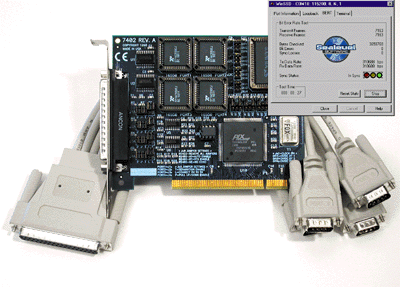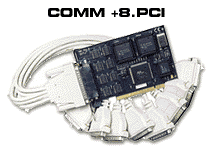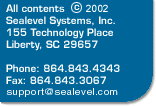| The following article was drafted by Sealevel and appeared in the July 2000 issue of Control.
 Serial I/O Boards Provide PCI Bus Interfaces Serial I/O Boards Provide PCI Bus Interfaces
As factory automation continues to evolve into a mixture of fieldbus technologies (Modbus, Profibus, DeviceNet, etc.) and Ethernet, an older stand-by remains the cornerstone of industrial communications: RS-485. "A rugged and reliable serial port is in many cases the workhorse of the typical industrial PC," says Dave Pratt, director of product management, Sealevel Systems Inc., Liberty, SC. "The serial port is still used as a primary source of input to the PC."
RS-485 has been around since the early days of DOS. Implementation was simple because DOS allowed direct control of hardware. With the arrival of Windows, RS-485 communications became increasingly difficult. Windows abstracts the application program from the specific details of I/O device programming, so software cannot directly control the raising and lowering of the Request To Send signal (RTS) for RS-485 communications. Software applications must make calls to a software driver to control the hardware in the system.
The Windows serial driver that normally gets associated with serial ports does not support RS-485 communications. To remedy this deficiency, Sealevel Systems designed an innovative hardware solution known as the ULTRA circuit, which handles the raising and lowering of the RS-485 driver enable signal automatically, eliminating the need for special software. (For applications where a software solution is required, or for non-ULTRA cards, Sealevel's enhanced Windows serial drivers, SeaCOM, can be used for RS-485 line control.)
Sealevel's new ULTRA family of PCI serial I/O boards provides simple to use one, two, and four-port isolated and non-isolated RS-232/422/485 communications for PCI 2.1. "Sealevel Systems has in the past provided serial I/O boards for the PCI and ISA bus, and our intent is to provide the same quality, reliability, and excellence of design to our new isolated PCI bus interfaces," says Pratt. "These features are expected from a Sealevel Systems' adapter. The solidity of its design provides a guarantee of its reliability.
Developed around the 16550 UART, the new family ensures compatibility with existing drivers and applications while significantly increasing the amount of data that can be captured, without using up a significant amount of system resources.
The isolated cards' onboard opto-isolators eliminate spikes and surges. "Isolation is important in installations where the equipment connected to the PC is located far from the host system, or in installations between two or more buildings with different ground potentials," says Rudolph Fulgham, project engineer at Sealevel. "The resulting spike on the line [ground loop current] can cause failure and destruction of serial cards and oftentimes connected equipment."
Various UART options are available extending the versatility of the products. The ULTRA boards ship with 16550 UARTs standard, providing a 16-byte FIFO buffer. 16850 UARTs are available offering a deeper 128-byte FIFO buffer and enhanced clocking.
"A user-configurable selection on the board determines the speed of the clock provided to the UART," says Jeff Hunter, technical support. This clock is selectable from the standard 1.8432 MHz. input (DIV4 selection) to 7.3728 MHz. input (DIV1 selection). "This ability to be both compatible with standard application data rates as well as run at high speeds provides needed flexibility in the industrial automation market--while one port is running a data collection task, another port can be controlling a high-speed automation process."
Sealevel ULTRA cards use an accelerated UART clock frequency to increase data rates up to 460.8K bps. The onboard clock division circuit jumper block determines the rate of data acceleration. This circuit allows the user to select the clocking mode most appropriate to suit the particular application. "With the maximum acceleration of DIV1 selected, the software application's data rate setting will actually be four times greater than requested," says Pratt. "This allows applications developed with 115.2 Kbps as the maximum setting to run at 460.8 Kbps.
The company provides advanced Windows 95/98/NT and 2000 COM: drivers and test applications allowing enhanced UART configuration (16650, 16750, 16850, and higher), RS-485 software control (not needed with ULTRA cards, but included), bit error rate test, terminal, and loop back test applications.
"Installation could not be simpler," says Tim Henning, technical support. "Plug the card into an open PCI slot and power up the system." In a plug-and-play operating system such as Windows 95/98/2000, the product is automatically configured by the system's BIOS to a range of unoccupied I/O addresses. In Windows NT, which is not plug-and-play, Sealevel's driver software assists in configuring the operating system settings to match the hardware as configured by the BIOS.
The slot where the card is installed determines the interrupt request line (IRQ) assigned to the adapter. All ports share a single IRQ, allowing the card's use of system resources to remain very small. Sealevel Systems also has a complete line of Multiport RS-232, Digital I/O, and high speed Sync/Async cards to suit a wide variety of communication tasks.
The following article was drafted by Sealevel and appeared in the November 1998 issue of Control and Control Design.
 PCI Serial-Interface Card Keeps Up With User Demands PCI Serial-Interface Card Keeps Up With User Demands
As personal computers increase in power and drop in price, they are more frequently being used in applications that were considered not feasible for automation or where proprietary custom designs were used. Companies that once relied on their internal engineering groups to design system components are now choosing off-the-shelf solutions.
Sealevel Systems, Inc., a liberty South Carolina-based supplier of communications and I/O products, is targeting the industry's need for high quality serial ports to control processes and collect data from intelligent devices by introducing the COMM+8.PCI Serial Interface card along with a family of RS-232 and automatic RS-422/485 products.
"The COMM+8.PCI was created with the goal of providing an easy-to-use eight-port serial I/O board for the PCI bus," says David Pratt, Product Marketing Manager. "Sealevel Systems has provided two, four and eight-port boards for ISA-based computers and it's our intention to provide the same quality, reliability and design to PCI-based interfaces." The card features a fully compliant PCI 2.1 bus interface, high-speed RS-232 capable transceivers, and advanced UARTs. Designed around the 16554 Quad UART, it provides ensured capability with existing drivers and applications. The transceivers are fully EIA/TIA-232/574 compliant, while providing for higher data rates.
"We considered these design goals important because the asynchronous communications port is the work horse of the typical PC," continues Pratt. "It is used as the primary source of external input to the PC and this eight-port interface significantly increases the amount of data that can be captured without using up a significant amount of system resources." The COMM+8.PCI has a comprehensive list of features designed to make installation simple and provide robust communications. "The easy integration of programmable logic controllers (PLCs), bar code readers, process control equipment, terminals, and other data collection devices was the design objective," says Pratt.
The COMM+8.PCI ships with 16554 UARTs standard, provided a 16-byte FIFO buffer, and is available with a deeper 64-byte FIFO buffer and enhanced clocking. Deeper FIFOs can be important in graphic-intensive Windows applications requiring a lot of processor overhead, or where data is logged across networks, slowing response time to service the serial line.
"The cards onboard interrupt status port is important for maximizing the efficiency of Windows communications," says Pratt. "It directs the interrupt service routine to the port that generated an interrupt so that the data can be serviced quickly and efficiently without the need to poll each port separately." Sealevel Systems provides advanced COMM: drivers with the COMM+8.PCI that allow interrupt sharing to take place seamlessly with DOS and all 32-bit Windows operating systems. The card supports data rates up to 460.8 Kbps using its onboard clock division circuit.
The card plugs into an open PCI slot and is automatically configured the system BIOS to a range of unoccupied I/O addresses. The slot where the card is installed determines the interrupt request line assigned to the adapter. All eight ports share a single IRQ, allowing the use of system resources to remain modest. Software included provides Windows 95/98 and NT Advanced COMM: drivers allowing IRQ sharing, support for advanced UARTs, support for RS-485 auto RTS enable/disable for Sealevel Systems legacy RS-485 serial I/O adapters, and other features not available in the standards Windows COMM: driver.
"The PCI design makes it a bus to consider for expansion needs," adds Rudolph Fulgham, Member, Technical Support II. "Being plug-and-play, it should have no address or IRQ resource contention problems. If problems arise they can typically be solved by switching to a different slot on the motherboard and the only user-configurable selection on the board determines the speed of the clock provided to the UART." The clock is selectable from the standard 1.8432 MHZ up to 7.3728 MHZ input.
|





